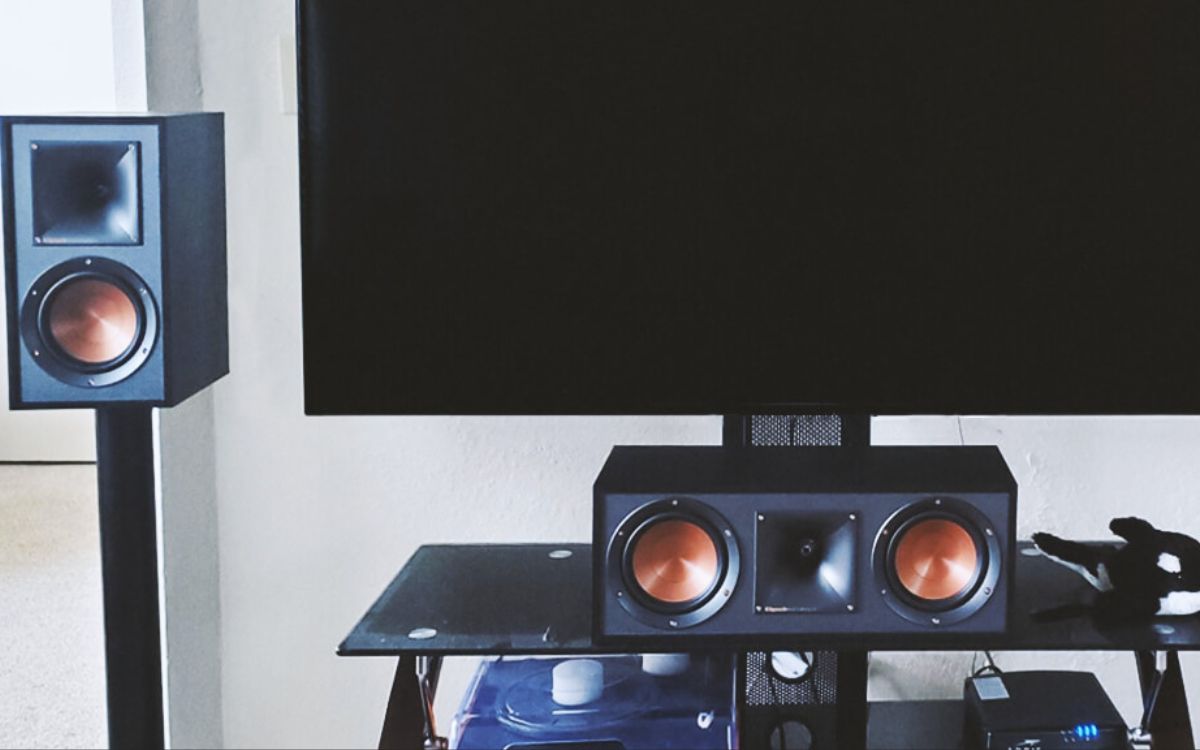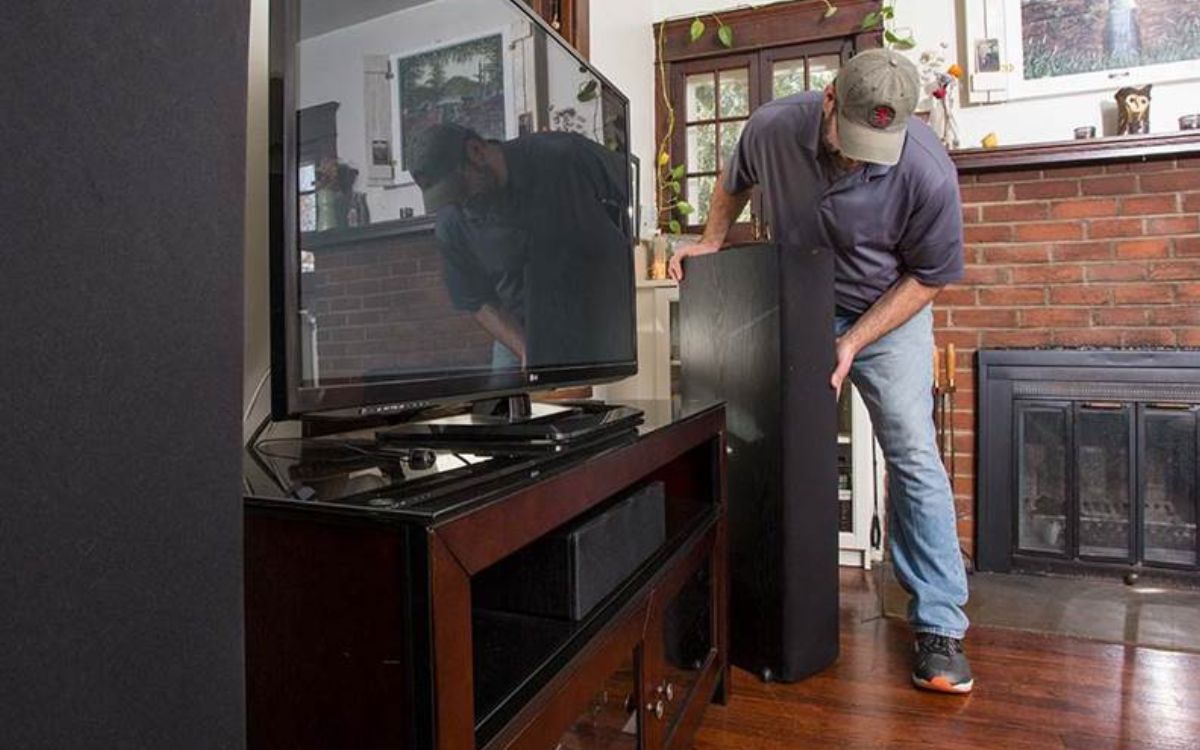Home>Production & Technology>Surround Sound>Why Does My Surround Sound Keep Sounding Like Its Blowing Up


Surround Sound
Why Does My Surround Sound Keep Sounding Like Its Blowing Up
Modified: February 18, 2024
Discover why your surround sound system keeps sounding like it's blowing up. Get expert advice to fix the issue and enjoy immersive audio experience.
(Many of the links in this article redirect to a specific reviewed product. Your purchase of these products through affiliate links helps to generate commission for AudioLover.com, at no extra cost. Learn more)
Table of Contents
Introduction
Surround sound systems are a popular choice for home theaters and audio enthusiasts, providing an immersive audio experience that enhances the enjoyment of movies, music, and gaming. However, it can be incredibly frustrating when your surround sound system starts sounding distorted, as if it’s about to blow up. This not only ruins your listening experience but can also indicate potential issues with your audio setup.
Distorted surround sound can manifest in various ways, such as crackling, popping, buzzing, or a general muffled sound. Identifying the cause of the distortion is crucial in order to address the issue and restore your surround sound system to its optimal performance.
In this article, we will explore some of the possible causes of distorted surround sound and provide tips on how to prevent it. Whether you’re a seasoned audiophile or a beginner in the world of surround sound, understanding these factors will enable you to troubleshoot and enjoy a crystal-clear audio experience.
Possible Causes of Distorted Surround Sound
When your surround sound system starts sounding like it’s on the verge of blowing up, there are several potential culprits to consider. Here are some common causes of distorted surround sound:
- Speaker Placement: Improper speaker placement can lead to distorted sound. Make sure your speakers are positioned correctly, as per the manufacturer’s guidelines, to ensure optimal audio performance.
- Incorrect Speaker Connections: If the speakers are not connected properly to the receiver or amplifier, it can result in distorted sound. Double-check the wiring connections to ensure they are secure and properly plugged in.
- Amplifier Overload: If you push your amplifier beyond its limits, it can cause distortion. Avoid cranking up the volume to the maximum level or surpassing the power rating of your speakers, as it can strain the amplifier and lead to distorted sound.
- Audio Calibration Issues: Improper audio calibration settings can affect the overall sound quality. Take the time to correctly set up your surround sound system, including adjusting speaker levels, crossover frequencies, and room correction settings.
- Faulty or Damaged Speakers: Defective or damaged speakers can produce distorted sound. Check for any visible damage or unusual sounds coming from the speakers. If necessary, replace or repair the faulty speakers to ensure optimal audio performance.
- Compatibility Issues with Audio Sources: Certain audio sources, such as low-quality recordings or incompatible audio formats, can contribute to distorted sound. Use high-quality audio sources and ensure compatibility with your surround sound system for the best audio experience.
- Electrical Interference: Electrical interference from other devices in close proximity can disrupt the audio signal and result in distorted sound. Keep your surround sound system away from other electronic equipment, such as Wi-Fi routers or microwaves, to minimize the risk of interference.
These are just a few possible causes of distorted surround sound. It’s important to assess each factor and troubleshoot accordingly to pinpoint the exact cause and resolve the issue. Let’s now move on to some practical tips to prevent surround sound distortion and maintain optimal audio performance.
Speaker Placement
The placement of your speakers plays a crucial role in achieving optimal surround sound quality. Incorrect speaker placement can result in imbalanced sound distribution, phase cancellation, and ultimately, distorted audio. Here are some tips to ensure proper speaker placement:
- Front Speakers: Place your front speakers at equal distances from the center of your listening area. Ideally, they should be positioned at ear level for the best sound projection.
- Center Speaker: The center speaker should be positioned directly above or below the television screen, facing the listeners. This ensures clear dialogue and anchors the sound in the center.
- Surround Speakers: The surround speakers should be placed slightly behind the listener’s seating position, approximately 2-3 feet above ear level. They should create a spacious sound field without overpowering the front speakers.
- Subwoofer: The subwoofer can be placed anywhere in the room, as low-frequency sounds are non-directional. Experiment with different locations to find the spot that provides the best bass response and blends well with the other speakers.
- Room Acoustics: Take into account the acoustic properties of the room. Hard surfaces can cause sound reflections, leading to muddied or distorted audio. Consider using acoustic panels, rugs, or curtains to minimize reflections and improve sound quality.
- Speaker Distance: Ensure that the distance between each speaker is the same. Consistent spacing enhances sound coherence and prevents phase cancellation. Refer to your speaker’s manual for recommended distances based on your listening area.
- Speaker Angles: Angle the front and surround speakers towards the listening area to optimize sound dispersion. This helps create a focused soundstage and improves audio clarity.
- Testing and Fine-tuning: Experiment with different speaker placements and make use of audio calibration tools, such as a sound pressure level meter or room correction software, to fine-tune the speaker positions for the best possible sound performance.
By carefully considering and implementing proper speaker placement techniques, you can greatly enhance your surround sound experience and minimize the risk of distorted audio. Take the time to experiment and find the optimal configuration that works best for your specific room and listening preferences.
Incorrect Speaker Connections
One common cause of distorted surround sound is incorrect speaker connections. If the speakers are not properly connected to the receiver or amplifier, it can result in poor audio quality and potential distortion. Here are some tips to ensure correct speaker connections:
- Double-Check Wiring: Make sure that the speaker wires are securely connected to the corresponding terminals on the back of the receiver or amplifier. Loose or poorly connected wires can cause intermittent sound or distortion.
- Color Coding: Many speakers and receivers are equipped with color-coded terminals or plugs. Match the corresponding colors on the speaker wires with the appropriate terminals to ensure proper channel assignment.
- Polarity: Pay attention to the polarity of the speaker wires. Each wire usually has a positive (+) and negative (-) end. Ensure that the positive terminal of the speaker is connected to the corresponding positive terminal on the receiver or amplifier, and vice versa.
- Secure Connections: Ensure that the speaker wire is tightly secured and not loose. Loose connections can cause signal loss and result in distorted sound.
- No Stray Wires: Make sure that there are no stray wires touching each other or coming into contact with metal objects. Stray wires can cause short circuits and affect audio quality.
- Use High-Quality Speaker Wire: Invest in good quality speaker wire to minimize signal loss and maximize audio integrity. Thick-gauge copper wire is typically recommended for optimal audio performance.
- Speaker Placement and Distance: Ensure that the speakers are placed in the correct locations and positioned at the recommended distances. Incorrect speaker placement can affect the sound balance and result in distorted audio.
- Periodic Inspection: Regularly check the speaker connections to ensure they remain secure over time. Loose connections can occur due to vibrations or accidental tugging, so it’s important to periodically inspect and re-tighten if necessary.
By following these guidelines and ensuring correct speaker connections, you can prevent potential distorted sound caused by improper wiring. It’s essential to establish secure and accurate connections to maintain the integrity of the audio signal and enjoy a high-quality surround sound experience.
Amplifier Overload
Amplifier overload is another common cause of distorted surround sound. When you push your amplifier beyond its limits, it can lead to clipped or distorted audio. Here are some tips to prevent amplifier overload:
- Know Your Amplifier’s Power Rating: Check the power rating of your amplifier or receiver and understand its capabilities. It’s important to match the power requirements of your speakers with the amplifier’s output power to avoid overloading.
- Avoid Maxing Out the Volume: Resist the temptation to crank up the volume to the maximum level. Pushing the amplifier to its maximum capacity can lead to distortion. Instead, find a comfortable listening level that allows the amplifier to operate within its optimal range.
- Beware of Dynamic Range Compression: Some audio content, such as movies or music with wide dynamic range, may have sudden peaks in volume. Enabling dynamic range compression in your audio settings can help to prevent amplifier overload by reducing extreme volume differences.
- Use High-Quality Audio Sources: Low-quality audio files or heavily compressed formats may contain artifacts or clipping. Using high-quality audio sources allows your amplifier to reproduce the audio signals accurately without introducing additional distortion.
- Consider Upgrading Your Amplifier: If you consistently find that your amplifier is struggling to deliver clean and distortion-free sound, it may be time to upgrade to a more powerful and capable model that can handle your audio needs.
- Monitor Temperature: Amplifiers can generate heat when operating at higher power levels. Ensure proper ventilation and monitor the temperature to prevent overheating, which can affect the amplifier’s performance and lead to potential distortion.
- Speaker Impedance: Check the compatibility between your amplifier and speakers in terms of impedance. Using speakers with an impedance that is too low or too high for the amplifier can cause stress on the amplifier and potentially result in distortion.
- Use an External Power Amplifier: If you have a large and demanding audio system, consider using an external power amplifier to drive your speakers. This allows the main amplifier or receiver to operate within its optimal range without excessive strain.
By being mindful of your amplifier’s capabilities and implementing these preventive measures, you can ensure that your amplifier operates within a safe range, minimizing the risk of distortion and preserving the audio fidelity of your surround sound system.
Audio Calibration Issues
Audio calibration refers to the process of adjusting various settings and parameters of your surround sound system to achieve optimal audio performance. Incorrect audio calibration can contribute to distorted surround sound. Here are some common audio calibration issues to consider:
- Speaker Levels: Each speaker in your surround sound system should be balanced in terms of volume. Use the built-in audio calibration tools or an external sound pressure level meter to adjust the speaker levels to ensure consistent sound projection.
- Crossover Frequencies: The crossover frequency determines which frequencies are directed to the subwoofer and which are directed to the main speakers. Incorrect crossover settings can lead to imbalanced bass response or excessive overlap, resulting in muddied or distorted sound. Consult your system’s manual or use an automatic calibration feature to set the appropriate crossover frequencies.
- Room Correction: Many modern AV receivers offer room correction software that analyzes the room acoustics and adjusts the audio settings accordingly. Ensure that your room correction feature is properly calibrated and updated to mitigate any issues related to room resonance or reverberation that can contribute to distortion.
- Delay Settings: Surround sound systems often have multiple speakers placed at different distances from the listener. Incorrect delay settings can result in audio inconsistencies and distortion. Use the appropriate delay settings to synchronize the arrival of sound from different speakers, creating a cohesive and accurate soundstage.
- EQ (Equalization) Settings: Fine-tuning the equalization settings can help to compensate for any audio imbalances caused by the room or the speakers. Adjust the EQ settings based on your listening preferences and the sonic characteristics of your room, taking care not to introduce excessive boosts or cuts that can lead to distortion.
- Calibration Microphone Placement: If you are using an automatic calibration feature that requires a microphone, ensure that the microphone is placed in the correct listening position. Incorrect microphone placement can result in inaccurate audio measurements and subsequently affect the calibration results.
- Regular Calibration Updates: Over time, the acoustic characteristics of your room may change due to factors like furniture rearrangement or room modifications. Periodically recalibrate your audio settings to account for these changes and maintain optimal audio performance.
By addressing audio calibration issues and ensuring that your surround sound system is properly configured, you can minimize distortion and enjoy a well-balanced and immersive audio experience.
Faulty or Damaged Speakers
One of the potential culprits behind distorted surround sound is faulty or damaged speakers. If the speakers themselves are not functioning properly, it can result in poor audio quality and noticeable distortion. Here are some considerations regarding faulty or damaged speakers:
- Inspect for Visible Damage: Visually inspect your speakers for any signs of physical damage such as dents, tears in the speaker cone, or loose connections. These issues can directly impact the sound quality and may lead to distortion.
- Listen for Unusual Sounds: Pay attention to any strange sounds coming from the speakers, such as buzzing, rattling, or popping noises. These can indicate internal damage or loose components, which can contribute to distorted sound.
- Perform Speaker Test: Most AV receivers have a built-in speaker test function that allows you to check each speaker individually. Use this feature to ensure that each speaker is producing sound in a balanced and distortion-free manner.
- Swap Speakers: If you suspect a specific speaker is the source of the distortion, try swapping it with another speaker in your system. By doing this, you can determine if the distortion follows the speaker or remains in the same location, helping to identify the faulty component.
- Check Speaker Connections: Ensure that the speaker wires are securely connected to the speakers and the receiver. Loose connections can introduce distortion or intermittent sound issues. Additionally, verify that the speaker wires themselves are not frayed or damaged.
- Consider Professional Inspection or Repair: If you have gone through the troubleshooting steps and suspect that the speakers are indeed faulty, it may be necessary to seek professional help. An audio technician or speaker repair specialist can diagnose and fix any internal issues, ensuring optimal audio performance.
- Consider Speaker Replacement: If your speakers are old, outdated, or beyond repair, it may be time to consider replacing them. Upgrading to new, high-quality speakers can significantly improve the audio fidelity and reduce the chances of distortion in your surround sound system.
- Proper Speaker Maintenance: Regularly clean and maintain your speakers to ensure they function optimally. Dust and debris buildup can affect the speaker’s performance, leading to distortion. Use a soft cloth or a brush to gently remove any dirt or grime from the speaker surfaces.
By examining your speakers for any visible damage, listening for unusual sounds, and conducting tests, you can identify any faulty or damaged speakers and take the necessary steps to address the issue. Ensuring that your speakers are in good working condition is crucial for achieving distortion-free surround sound.
Compatibility Issues with Audio Sources
Compatibility issues with audio sources can contribute to distorted surround sound. Certain audio sources may not be compatible with your surround sound system, resulting in compromised audio quality. Here are some considerations regarding compatibility issues:
- Audio Format Compatibility: Different audio formats, such as Dolby Digital, DTS, or PCM, are designed to be decoded and reproduced by specific audio systems. Verify that your surround sound system supports the audio formats used by your audio sources to ensure optimal compatibility and prevent distortion.
- Bitrate and Sample Rate: High-quality audio recordings often have higher bitrates and sample rates. If your system is unable to handle the high bitrate or sample rate of an audio source, it may result in distorted sound. Check the specifications of your surround sound system to ensure compatibility with the audio source.
- Low-Quality Audio Sources: Low-quality audio files, such as highly compressed MP3s or streaming services with low bitrates, may inherently suffer from degraded audio quality and introduce distortion. Whenever possible, use high-quality audio sources to ensure the best audio experience.
- Volume Level Normalization: Some audio sources may have variable volume levels, resulting in sudden shifts in volume during playback. This can cause distortion or clipping. Enable volume level normalization features on your audio playback device or application to maintain a consistent volume level and minimize distortion.
- Audio Source Connections: Check the connections and cables between your audio source devices and the surround sound system. Loose or faulty connections can cause intermittent audio issues and potentially introduce distortion. Ensure that the cables are securely plugged in and in good condition.
- Firmware Updates: Manufacturers often release firmware updates for audio devices to improve compatibility with new audio formats or address known issues. Check for any available firmware updates for your surround sound system and audio sources to ensure optimal compatibility and performance.
- Audio Settings and Presets: Explore the audio settings and presets on your surround sound system and audio sources. Adjustments such as EQ settings, audio modes, or virtual surround sound features can help enhance audio playback and potentially mitigate any distortion issues.
- Audio Source Quality: Opt for high-quality and well-recorded audio sources to ensure the best possible sound reproduction. Consider investing in lossless audio formats or high-resolution audio files to minimize the risk of distortion caused by low-quality recordings.
By addressing compatibility issues and ensuring that your surround sound system is compatible with your audio sources, you can enjoy distortion-free playback and maximize the audio quality of your surround sound system.
Electrical Interference
Electrical interference can be a significant factor contributing to distorted surround sound. Other electronic devices in the vicinity of your surround sound system can generate electromagnetic interference (EMI) or radio frequency interference (RFI), which can disrupt the audio signal and result in distortion. Here are some considerations regarding electrical interference:
- Avoid Proximity to Other Electronics: Keep your surround sound system away from other electronic devices that emit electromagnetic fields or radio waves, such as Wi-Fi routers, cordless phones, or microwave ovens. These devices can interfere with the audio signal and cause distortion.
- Use Shielded Cables: Shielded audio cables can help minimize the impact of electromagnetic interference. Consider using shielded speaker cables or interconnect cables to reduce the chances of distortion caused by electrical interference.
- Power Conditioners or Surge Protectors: Electrical noise and power fluctuations can introduce distortion to the audio signal. Using power conditioners or surge protectors with built-in noise filters can help to reduce these disturbances and improve audio quality.
- Grounding: Ensure that your surround sound system and other electronic devices are properly grounded. Poor grounding can result in ground loops, which can introduce unwanted noise and distortion. Consult an electrician if you suspect any grounding issues.
- Wireless Interference: If you’re using wireless speakers or wireless transmitter and receiver systems, be aware of potential interference from other wireless devices operating on the same frequency. Try selecting a less congested frequency or reposition the wireless devices to minimize interference.
- Isolate Audio Cables: Keep audio cables away from power cables or other sources of electrical interference. Crossing or running audio cables parallel to power cables can cause interference, leading to distortion. Whenever possible, route the audio cables separately or at a significant distance from power cables.
- Ferrite Cores: Consider using ferrite cores on your audio cables. These magnetic cores can help to suppress high-frequency noise and minimize the chances of interference affecting the audio signal, reducing the likelihood of distortion.
- Locate and Eliminate Noise Sources: If you notice persistent distortion or noise in your surround sound system, try identifying the potential noise sources. Temporarily power off or unplug electronic devices one by one to identify the culprit causing the interference and resolve the issue.
By implementing these measures and minimizing electrical interference, you can significantly reduce the risk of distortion caused by external electromagnetic or radio frequency interference, ensuring a clean and distortion-free surround sound experience.
Tips to Prevent Surround Sound Distortion
Preventing surround sound distortion requires careful attention to various aspects of your audio setup. By following these tips, you can minimize the chances of distortion and ensure a high-quality audio experience:
- Choose Quality Equipment: Invest in high-quality speakers, amplifiers, and audio sources. Well-built and reputable audio equipment can provide better sound reproduction and reduce the likelihood of distortion.
- Proper Speaker Placement: Position your speakers correctly, following manufacturer guidelines, to optimize sound projection and imaging. Pay attention to distances, angles, and heights to create an immersive audio environment.
- Ensure Correct Speaker Connections: Double-check that all speaker wires are securely attached to their respective terminals. Loose or incorrect connections can introduce distortion or intermittent sound issues.
- Monitor Amplifier and Speaker Levels: Avoid pushing your amplifier or speakers to their maximum limits. Balance the volume levels of each speaker and ensure that the amplifier operates within its safe range to prevent distortion.
- Calibrate Audio Settings: Use the built-in calibration tools, room correction software, and equalizer settings to optimize the audio performance. Adjust settings such as crossover frequencies, speaker levels, and equalization to achieve a balanced and accurate sound.
- Use High-Quality Audio Sources: Opt for high-resolution audio files, lossless formats, or uncompressed audio whenever possible. High-quality sources minimize the risk of distortion caused by compression artifacts or low bitrates.
- Minimize Background Noise: Reduce ambient noise in your listening environment to allow the subtle details of audio to be more audible. Close windows, use curtains or blinds, and consider using acoustic treatments to minimize external noise interference.
- Maintain Adequate Ventilation: Surround sound systems can generate heat, particularly amplifiers and receivers. Ensure proper ventilation to prevent overheating, which can affect performance and potentially lead to distortion.
- Regular Maintenance: Clean your speakers and audio equipment regularly to prevent dust and debris buildup that can affect sound quality. Inspect cables, connectors, and wiring for any damage and replace if necessary.
- Stay Updated: Keep your audio equipment firmware, software, and drivers up to date. Manufacturers often release updates that address compatibility issues, fix bugs, and enhance overall audio performance.
By implementing these tips, you can maintain an optimal audio setup and minimize the chances of surround sound distortion. Remember to periodically reassess and fine-tune your system to ensure continuous high-quality audio performance.
Conclusion
Surround sound systems offer an immersive audio experience that elevates your entertainment and gaming activities. However, dealing with distorted surround sound can be frustrating and hinder your enjoyment. By understanding the possible causes and implementing preventive measures, you can effectively minimize the chances of distortion and maintain optimal audio quality in your surround sound system.
We have explored various factors that can contribute to distorted surround sound, such as speaker placement, incorrect connections, amplifier overload, audio calibration issues, faulty speakers, compatibility issues, and electrical interference. Each of these factors requires attention and careful troubleshooting to identify and rectify the specific issue.
To prevent surround sound distortion, it’s crucial to follow recommended speaker placement guidelines, ensure correct speaker connections, and avoid overloading your amplifier. Proper audio calibration, including adjusting speaker levels, crossover frequencies, and room correction settings, helps achieve balanced and accurate sound reproduction. Regular inspection of speakers for damage, using compatible audio sources, and minimizing electrical interference are also essential to maintaining distortion-free surround sound.
By following these tips and implementing preventative measures, you can enjoy a high-quality surround sound experience with crisp, clear, and immersive audio. Take the time to optimize your audio settings, invest in quality equipment, and create a conducive listening environment to maximize the potential of your surround sound system.
Remember, the journey to achieving distortion-free surround sound may involve some trial and error, as each audio setup is unique. However, with attention to detail and ongoing maintenance, you can create an audio experience that truly enhances your entertainment and brings your favorite content to life.











